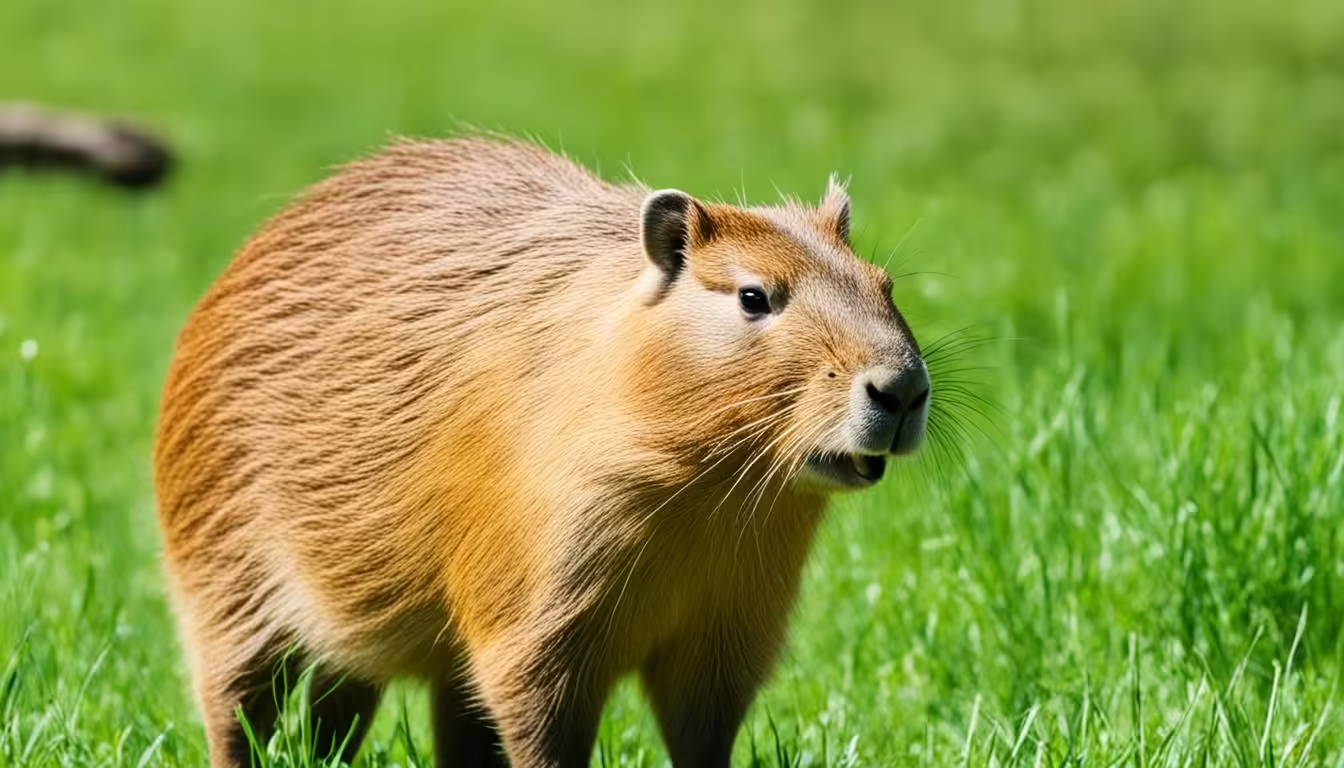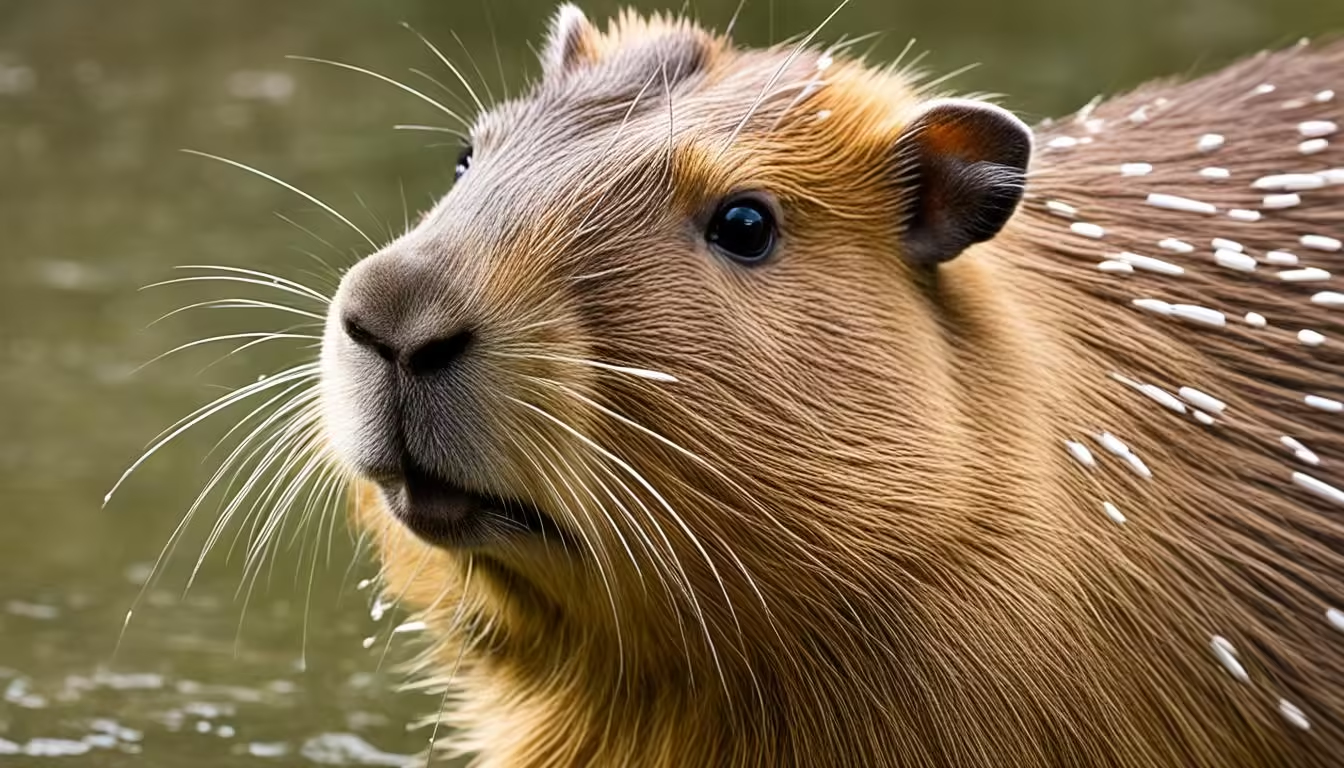Capybaras are often seen as friendly and social. But, it’s important to know about their risks and safety. This article will look into whether capybaras can be harmful, their defense strategies, and how they interact with humans. By the end, you’ll know how to stay safe around these amazing animals.
Key Takeaways
- Capybaras are seen as non-dangerous but can defend themselves when needed.
- Their strong bite and territorial nature mean we should keep a safe distance and not scare them.
- Knowing how capybaras live and what they need can help prevent problems and keep interactions safe.
- It’s important to take steps like giving them the right homes and respecting their natural ways when we meet capybaras.
- It’s not a good idea to keep capybaras as pets because they have complex needs.
Introduction to Capybaras
Classification and Physical Characteristics
Capybaras (Hydrochoerus hydrochaeris) belong to the Caviidae family, like guinea pigs and rock cavies. They are the biggest rodents alive, growing up to 1.3 meters (4.3 feet) long and weighing 35 to 66 kilograms (77 to 146 pounds). They have a sturdy, barrel-shaped body, webbed toes for swimming, and reddish-brown to dark brown fur. This fur helps them hide in their water homes. They also have pig-like snouts, small eyes, and big ears, perfect for living partly in water.
Natural Habitat and Distribution
Capybaras live in northern and central South America, from Colombia and Venezuela to Uruguay and northeastern Argentina. They love wetland areas like marshes, rivers, lakes, and flooded savannas. These places offer lots of water plants for them to eat. They need permanent water and like places with lots of plants for hiding and making nests.
A few capybaras have made their home in Florida, the United States, and parts of Japan. This is because they are popular in zoos and as pets.
“Capybaras are often found in groups of 10 to 20 individuals, although groups can sometimes be much larger. Females can give birth to litters ranging from one to eight offspring and can reproduce multiple times a year.”
Temperament and Behavior
Capybaras are the biggest rodents in the world, known for being gentle and friendly. They live in groups of up to 40, with a strong leader. They are often called the “gentle giants” of rodents. But, they can be aggressive when they feel threatened or need to protect their young or territory.
Social Structure and Hierarchy
In capybara groups, there’s a clear leader who keeps order. When males get older, they often leave the group. The females and their kids stay together. This way, the group stays stable and united.
Capybaras talk to each other in many ways, like purring, making clicks, whistling, and grunting. They also use smells to talk to each other, with leaders marking their territory more often.
These animals get along with many other animals, like cows and some birds. They even live with domestic cattle and certain bird species. This shows how friendly and adaptable capybaras are.
““Capybaras are the world’s largest rodents, weighing up to 170 pounds. Despite their size, they are known for their gentle and social nature, living in large groups and forming strong hierarchical structures.”
| Behavior Trait | Description |
|---|---|
| Herd Dynamics | Capybaras typically live in groups of up to 40 individuals, with a dominant male leading the herd. |
| Hierarchy | Capybara social structure is characterized by a stable hierarchy, with the dominant male maintaining authority over the group. |
| Vocalization | Capybaras communicate using a range of sounds, including purring, clicking, whistles, squeals, grunts, and alarm barks. |
| Scent Marking | Capybaras use olfaction and scent marking to communicate, with dominant individuals engaging in more scent-marking behaviors. |
| Interspecies Interactions | Capybaras have been observed coexisting and interacting with various other species, including domestic cattle and several bird species. |
Potential Risks and Dangers
Capybaras are not usually dangerous to people. But, they have risks and ways to defend themselves. They can be big, weighing from 60 to 174 pounds, and have strong jaws. If they feel threatened, they can hurt people badly.
Defensive Behaviors and Aggression
Capybaras can get aggressive, especially when they think their babies or territory is in danger. They have a strong bite and can use their size to protect themselves. They also make sounds like barks and grunts to warn others.
When they are breeding or near their babies, capybaras might get more aggressive. It’s important to keep a safe distance and respect their space. This helps avoid any conflicts.
| Capybara Characteristics | Details |
|---|---|
| Weight Range | 60 to 174 pounds |
| Average Lifespan in the Wild | 4 to 8 years |
| Maximum Lifespan in Captivity | Up to 12 years |
| Height at the Shoulders | 20 to 24 inches |
| Vegetation Consumption per Day | Up to 8 pounds |
Knowing about the capybara risks and capybara dangers is important. It’s also key to understand their capybara defensive behaviors and capybara aggression. This way, people can have a safe and fun time with these amazing animals.
Can capybaras be harmful
Capybaras are usually friendly and don’t pose a big risk to people. But, they can be harmful in some situations. These big, water-loving rodents have traits that could lead to harm, even though attacks on humans are rare.
They have strong jaws and sharp teeth that grow all their lives. If they feel threatened, they might use these to defend themselves. If they think their territory or babies are in danger, they could get more aggressive. There have been some cases where capybaras bit or attacked people, usually when they were scared or trapped.
It’s key to keep a safe distance and not provoke or surprise capybaras. They are big and strong, so they could hurt you badly. Even though they eat plants, their bites can be deep and might lead to diseases like leptospirosis.
Knowing when a capybara might get aggressive, like if it growls or stands its ground, can help prevent bites. If you do get bitten, it’s important to get medical help right away.
Overall, capybaras are usually calm and nice. But, we should still be careful and respect their nature to avoid any bad encounters. Keeping a safe distance and understanding their need for space can make being around these interesting rodents safe and fun.
| Potential Risks of Capybara Interactions | Mitigating Measures |
|---|---|
|
|
By knowing the risks and being careful, we can safely enjoy these unique animals. This way, we can have fun with them without putting ourselves or them in danger.
Human-Capybara Conflicts
As humans move in and develop more, they bump into capybaras more often. These large rodents lose their homes because of habitat destruction. They then move into areas where humans live, looking for food and water. This can cause competition for resources and lead to negative human-capybara encounters.
Some capybaras face threats from humans who hunt them for their skin and meat. This hunting has led to a decline in their numbers in certain places. Managing capybara populations is important, but it must be done carefully to protect these unique animals.
Habitat Encroachment and Population Control
Human activities have greatly affected capybara habitats. Wetlands and natural areas are being turned into farms, homes, or industrial sites. This pushes capybaras out and forces them to live in areas with humans. This can cause problems like property damage, crop loss, or attacks on people.
To deal with this, some places have started controlling capybara populations. This can mean moving them, killing some, or using things to keep them away. But, these actions must be done in a way that is kind to the animals and good for the environment.
| Statistic | Value |
|---|---|
| Capybaras are the largest rodents in the world. | – |
| The cost of purchasing a Capybara can be around £1000. | – |
| Capybaras can eat 6-8lbs of grass per day. | – |
| Capybaras can live up to 10 years in captivity. | – |
| In the UK, a special license is required to own a Capybara as a pet. | – |
| Recorded 125 roadkill events between 2006 and 2019, with 70% occurring in 2019. | – |
Human activities have greatly affected capybara habitats. Wetlands and natural areas are being turned into farms, homes, or industrial sites. This pushes capybaras out and forces them to live in areas with humans. This can cause problems like property damage, crop loss, or attacks on people.
To deal with this, some places have started controlling capybara populations. This can mean moving them, killing some, or using things to keep them away. But, these actions must be done in a way that is kind to the animals and good for the environment.
Capybara Diseases and Transmission
Capybaras can get sick and might spread diseases to humans or other animals. These big rodents are usually healthy but can carry harmful germs. It’s important to know about the diseases they might spread, especially if you’re around them.
Research shows capybaras can carry viruses like coronaviruses. In Brazil, studies found SARS-CoV-2 in their feces and urine. This means they could spread the virus to people. Also, they might carry Orthopoxvirus DNA, which could make them disease carriers.
Parasites are another worry with capybaras. Many studies found lots of parasites inside them. For example, in Venezuela, 47.4% of capybaras had worms in their intestines. In Colombia, 33.2% of wild capybaras had protozoa in their stomachs.
Knowing the risks capybaras pose as disease spreaders is key. We need to follow good hygiene and have strict rules when around these animals. This helps keep both capybaras and people safe and healthy.
“Proper hygiene, quarantine protocols, and veterinary oversight are essential for ensuring the health and safety of both capybaras and those who encounter them.”
Environmental Impact
Capybaras, being the world’s largest rodents, play a big role in their ecosystems. They are known as “ecosystem engineers” because their eating and wallowing help keep wetlands balanced and diverse. These animals are a food source for many predators and their waste helps with nutrient cycling.
But, capybara numbers are dropping in some places due to hunting and losing their homes. This can harm the balance of the wetland communities. It’s important to protect capybaras and their homes to keep these ecosystems healthy.
Ecosystem Role and Consequences
Studies show capybaras are moving into drier areas, a change caused by forests being turned into farms and ranches. This change has made them eat different plants, including those eaten by cattle. In the Gran Chaco, a huge area across Argentina, Paraguay, and Bolivia, capybara numbers have gone up by about 50% in some areas.
Genetic studies show that capybara groups that were once separate are now mixing again. This is because of big changes in the environment in the Gran Chaco. With over 2,000 acres of Chaco forest being cut down every day, the increase in capybaras shows how ecosystems are changing. This can greatly affect the balance of the wetlands.
In cities like Campo Grande in Brazil, capybaras are moving closer to people, leading to more roadkill. Between 2006 and 2019, there were 125 roadkill incidents in Campo Grande, with most happening in 2019. The chance of a capybara getting hit by a car is lower if there are more parks around.
The impact of human actions on wildlife is clear in the Anthropocene era. Capybaras are a good example of how animals adapt to city life, which can lead to more car accidents. We need to think about how capybaras affect their environments and work on conservation to keep ecosystems balanced.
Capybara Safety and Precautions
When you meet capybaras, whether in a zoo or in the wild, be very careful. These big rodents might look friendly, but they can be strong and might get aggressive if not treated right. It’s important to be safe around them.
Keep a good distance and don’t make sudden moves or loud sounds. Let them have their space and act naturally. In places where people take care of them, make sure they have safe homes and rules for handling them.
Capybara Handling Precautions
- Never approach or handle capybaras without proper training and supervision.
- Maintain a safe distance and avoid sudden movements or loud noises that may startle the animals.
- Respect the capybaras’ space and natural behaviors, and do not attempt to interact with them directly.
- Ensure that captive enclosures are designed with the safety of both the capybaras and caretakers in mind.
- Follow established handling protocols and guidelines to minimize the risk of injury or aggression.
Capybara Interaction Guidelines
- Educate yourself on the species’ natural behaviors and habitat requirements.
- Seek guidance from experienced professionals when planning to interact with capybaras.
- Prioritize the well-being and safety of the animals over personal interactions or experiences.
- Respect local laws and regulations regarding the ownership, handling, and conservation of capybaras.
- Report any concerns or incidents related to capybara welfare or public safety to the appropriate authorities.
Following these safety tips and guidelines will help you have a safe and respectful meeting with these amazing animals. It also protects both the capybaras and the people who love them.
| Precaution | Rationale |
|---|---|
| Maintain a safe distance | Capybaras can be unpredictable and may react aggressively if they feel threatened. |
| Avoid sudden movements or loud noises | Sudden stimuli can startle capybaras and trigger defensive behaviors. |
| Respect the capybaras’ space and natural behaviors | Interfering with their natural behaviors can lead to stress and potential aggression. |
| Ensure proper enclosure design and handling protocols | Captive settings require specialized accommodations to ensure the safety of both capybaras and caretakers. |
“Capybaras are impressive creatures, but they deserve our respect and caution when interacting with them. By following established safety guidelines, we can enjoy their presence while prioritizing the well-being of both the animals and ourselves.”
Capybaras are the biggest rodents in the world and are known for being gentle and social. They are not usually dangerous to humans, but we should know the risks and safety tips. Learning about their behavior and how they interact with humans helps us appreciate them more and interact safely.
It’s important to protect capybara populations and their homes for the health of their ecosystems. With the right safety steps and respect for their needs, we can enjoy these “gentle giants” safely. This helps with their conservation and keeps the South American ecosystems vibrant.
We need to balance our interest in capybaras with their safety and protection. Through education and careful actions, we can live in harmony with capybaras. This ensures the well-being of both humans and capybaras.



